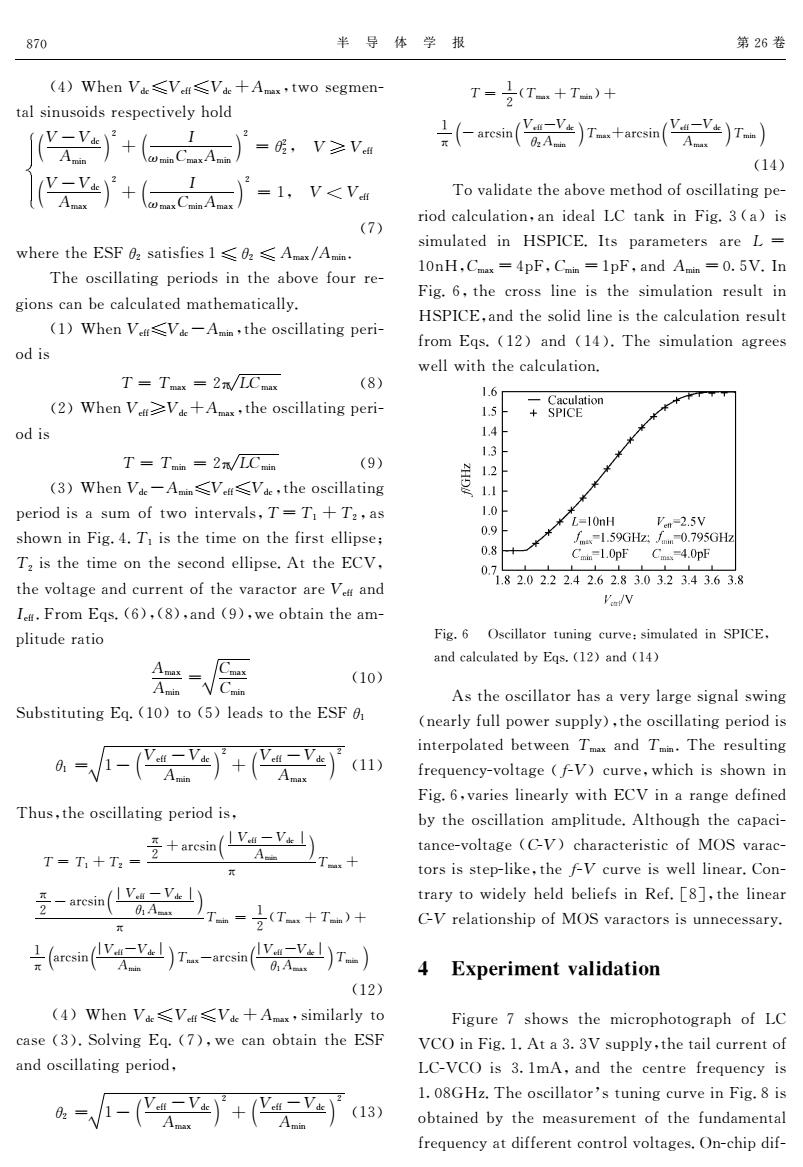正在加载图片...

870 半导体学报 第26卷 (4)When Vae≤Vf≤Vc+Amx,two segmen- T-(T+T)十 tal sinusoids respectively hold =,V≥V (14) To validate the above method of oscillating pe- riod calculation,an ideal LC tank in Fig.3(a)is (7) where the ESF02 satisfies 1≤2≤Amax/Amim simulated in HSPICE.Its parameters are L The oscillating periods in the above four re- 10nH,Cmax =4pF,Cmin =1pF,and Amin =0.5V.In Fig.6,the cross line is the simulation result in gions can be calculated mathematically. HSPICE,and the solid line is the calculation result (1)When VeVde-Amin,the oscillating peri- from Egs.(12)and (14).The simulation agrees od is well with the calculation. T=T=2r/LCmus (8) 1.6m (2)When VeuVde+Amax,the oscillating peri- -Caculation 1.5 SPICE od is 1.4 1.3 T=Tmin =2VLCmin (9) (3)When Vae-AminVVde,the oscillating period is a sum of two intervals,T=T1+T2,as 1.0上 L=10nH 0.9F 'm-2.5V shown in Fig.4.Ti is the time on the first ellipse; 1.59GHz:-0.795GHz 0.8+ T2 is the time on the second ellipse.At the ECV, Cm=1.0pF Ca=4.0pF 0. 1.82.02.22.42.62.83.0323.43.63.8 the voltage and current of the varactor are Ve and VV I.From Eqs.(6),(8),and (9),we obtain the am- plitude ratio Fig.6 Oscillator tuning curve:simulated in SPICE. and calculated by Eqs.(12)and (14) Anin Cmin (10) As the oscillator has a very large signal swing Substituting Eq.(10)to (5)leads to the ESF (nearly full power supply),the oscillating period is interpolated between Tmax and Tmin.The resulting A-+ frequency-voltage (f-V)curve,which is shown in Fig.6,varies linearly with ECV in a range defined Thus,the oscillating period is, by the oscillation amplitude.Although the capaci- AT十 tance-voltage (CV)characteristic of MOS varac- T=T1+T= tors is step-like,the f-V curve is well linear.Con- trary to widely held beliefs in Ref.[8],the linear CV relationship of MOS varactors is unnecessary. (arcsin(Tasin() 4 Experiment validation (12) (4)When Vae<VtVde+Amax,similarly to Figure 7 shows the microphotograph of LC case (3).Solving Eq.(7),we can obtain the ESF VCO in Fig.1.At a 3.3V supply,the tail current of and oscillating period, LC-VCO is 3.1mA,and the centre frequency is 1.08GHz.The oscillator's tuning curve in Fig.8 is --)+ (13) obtained by the measurement of the fundamental frequency at different control voltages.On-chip dif-半 导 体 学 报 第XW卷 !a"!<$)##H(#$AA(##HeS-*T#2]=8$3-$)/ 2*%8")(8="#81$8.$H2"G$%&<=%# # Z##H ! S-") " X V $ !%-")!-*TS-") " X T&X X# # &#$AA # Z##H ! S-*T " X V $ !%-*T!-")S-*T " X TY# # ’# ) * + $AA !P" ]<$1$2<$V,@&X8*2"8A"$8Y(&X (S-*T$S-")U ’<$=8H"%%*2")3.$1"=#8")2<$*+=G$A=(11$/ 3"=)8H*)+$H*%H(%*2$#-*2<$-*2"H*%%&c !Y"!<$)#$AA(##HgS-")#2<$=8H"%%*2")3.$1"/ =#"8 H TH-*T TX(%.!-*T !B" !X"!<$)#$AA&##HeS-*T#2<$=8H"%%*2")3.$1"/ =#"8 H TH-") TX(%.!-") !‘" !D"!<$)##HgS-")(#$AA(##H#2<$=8H"%%*2")3 .$1"=#"8*8(- =A2]=")2$1G*%8#HTHY VHX#*8 8<=])")@"3cacHY"82<$2"-$=)2<$A"182$%%".8$% HX"82<$2"-$=)2<$8$H=)#$%%".8$cE22<$VN\# 2<$G=%2*3$*)#H(11$)2=A2<$G*1*H2=1*1$#$AA*)# $$AAc@1=-VJ8c!W"#!B"#*)#!‘"#]$=+2*")2<$*-/ .%"2(#$1*2"= S-*T S-") T !-*T %!-") !Y[" ,(+82"2(2")3VJc!Y["2=!C"%$*#82=2<$V,@&Y &Y T YZ #$AAZ##H ! S-") " X V #$AAZ##H % ! S-*T " X !YY" ’<(8#2<$=8H"%%*2")3.$1"=#"8# H T HY VHX T ( X V*1H8") [#$AA Z##H[ ! S-") " ( H-*T V ( X Z*1H8") [#$AA Z##H[ ! &YS-*T " ( H-") T Y X!H-*T VH-")"V Y ( *1H8")[#$AAZ##H[ ! S-") "H)*TZ*1H8")[#$AAZ##H[ ! !&YS-*T "H-") " !YX" !a"!<$)##H(#$AA(##HeS-*T#8"-"%*1%&2= H*8$!D"c,=%G")3VJc!P"#]$H*)=+2*")2<$V,@ *)#=8H"%%*2")3.$1"=## &X T YZ #$AAZ##H ! S-*T " X V #$AAZ##H % ! S-") " X !YD" H T Y X!H-*T VH-")"V Y ( Z*1H8") #$AAZ##H !&XS-") "H-*TV*1H8") #$AAZ##H ! ! S-*T "H-") " !Ya" ’=G*%"#*2$2<$*+=G$-$2<=#=A=8H"%%*2")3.$/ 1"=#H*%H(%*2"=)#*)"#$*%7N2*)I")@"3cD!*""8 8"-(%*2$#") O,KLNVcL28 .*1*-$2$18 *1$ . d Y[)O#!-*T da.@#!-") dY.@#*)#S-") d[ZC\cL) @"3cW#2<$H1=88%")$"82<$8"-(%*2"=)1$8(%2") O,KLNV#*)#2<$8=%"#%")$"82<$H*%H(%*2"=)1$8(%2 A1=- VJ8c!YX"*)# !Ya"c’<$8"-(%*2"=)*31$$8 ]$%%]"2<2<$H*%H(%*2"=)c @"3cW R8H"%%*2=12()")3H(1G$&8"-(%*2$#"),KLNV# *)#H*%H(%*2$#+&VJ8c!YX"*)#!Ya" E82<$=8H"%%*2=1<*8*G$1&%*13$8"3)*%8]")3 !)$*1%&A(%%.=]$18(..%&"#2<$=8H"%%*2")3.$1"=#"8 ")2$1.=%*2$#+$2]$$)H-*T *)#H-")c’<$1$8(%2")3 A1$J($)H&/G=%2*3$!5"#"H(1G$#]<"H<"88<=])") @"3cW#G*1"$8%")$*1%&]"2<VN\")*1*)3$#$A")$# +&2<$=8H"%%*2"=)*-.%"2(#$cE%2<=(3<2<$H*.*H"/ 2*)H$/G=%2*3$!!"#"H<*1*H2$1"82"H=A QR,G*1*H/ 2=18"882$./%"I$#2<$5"# H(1G$"8]$%%%")$*1cN=)/ 21*1&2=]"#$%&<$%#+$%"$A8")6$Ac’B(#2<$%")$*1 !"#1$%*2"=)8<".=AQR,G*1*H2=18"8())$H$88*1&c V *ZB=?HO=F>W;9HK;>H8F @"3(1$P8<=]82<$ -"H1=.<=2=31*.< =A7N \NR")@"3cYcE2*DZD\8(..%<$2*"%H(11$)2=A 7N/\NR"8DZY-E#*)#2<$H$)21$A1$J($)H&"8 YZ[B0OUc’<$=8H"%%*2=1)82()")3H(1G$")@"3cB"8 =+2*")$#+&2<$ -$*8(1$-$)2=A2<$A()#*-$)2*% A1$J($)H&*2#"AA$1$)2H=)21=%G=%2*3$8cR)/H<".#"A/ BP[